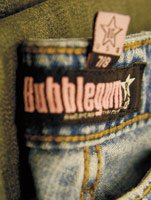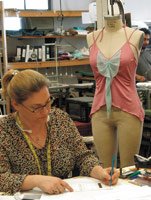Finding the Sweet Spot
Bubblegum USA’s eight-year ride to success took the company’s owners from Glider to glitter to carefully gauging teen trends
Down a bumpy street that runs through South Los Angeles, where heavily laden trucks have molded the asphalt into irregular shapes, sits the headquarters of Bubblegum USA, a juniors apparel manufacturer that has learned to thrive in a market shaped by the day-to-day whims of teen girls.
Inside the 60,000-square-foot brick building—which shares the neighborhood with metal recyclers, carpet importers and used-clothing exporters—nearly 200 people work to stay on top of the latest trends.
In the design room, Jorge Villand and his small staff of associate designers craft their latest silhouettes for a target market of 12- to 20-year-olds.
In the room next door, patternmakers, listening to the latest Nortentilde;a ballads from Mexico, sew the designers’ creations.
And in the company’s small sewing factory, 140 workers create quick-turn goods when reorders mandate a four- to six-week delivery time.
In the distribution room, many of these products fill cardboard boxes waiting to be shipped to big-name retailers across the country, including Bon Marcheacute;, Macy’s West and Mervyn’s.
After nearly eight years, Bubblegum USA has grown into a successful company that has weathered the ups and downs typical in the world of juniors apparel.
Surviving the juniors market has always been a challenge, but the task became more demanding last year when juniors sales in the United States declined 10.7 percent from 2002, according to Marshal Cohen, a retail expert with The NPD Group Inc., a consulting firm in Port Washington, N.Y.
This year, juniors sales are holding even with those of 2003. For the 12 months ending July 31, 2004, sales totaled $13.8 billion.
“The junior market is like a revolving door. It is a short segment of a consumer’s lifespan,” explained Cohen, who talks to about 100 consumers a week about their fashion preferences and buying habits. “The majority of teen consumers are only teen-agers from age 12 until 16. By the time they are 16, they are already aspiring to dress like a 20-year-old and live like a 24-year-old.”
So when John Inn and his wife, Laura Hong, launched their budding apparel venture in 1996 with $50,000 in capital, they were not sure what was going to happen. The recently married young entrepreneurs, who dreamt of carving their own niche in the competitive world of juniors apparel, decided to become fashion forerunners in the bottoms business, knowing full well that it was risky business competing in this arena. Being small, flexible and new helped them in many ways.
“At the time, we were able to move and run faster than the other guys,” recalled the 34-year-old Inn, who said his competition in those days was L.E.I. and Mudd, juniors manufacturers that still are among Bubblegum’s major competitors.
In the beginning, what set Bubblegum apart from other juniors companies was its use of stretch fabric. “We started with an eightounce stretch fabric and did well,” said Hong, the company’s 34-yearold creative director.
Stretch was still a budding concept in juniors fabrics and was not as popular as it is today. In just two short years, the gamble on stretch fabrics helped the company bring in $3.5 million in revenue.
Then in 1999, Inn and Hong hit upon a fabric they called “Glider,” a solid chintz polyester stretch fabric that they shaped into a fivepocket jean. It took off wildly. Glider helped the company boost its revenue to $27 million by 2000.
Although teens quickly snapped up the concept one year, they dropped it just as quickly the next. By 2000, the trend had ended abruptly, and Bubblegum USA was stuck with thousands of pants no longer in vogue.
“It just ended,” Inn said. “It took us by surprise. We thought we could run with this stuff, which turned out to be another learning experience. Fashion changes so fast—you never know when it is going to end.”
Inn and his wife ended up selling their surplus of Glider pants to discount stores. In addition, they hired longtime apparel industry veteran Kenneth Spiegel to help with operations and sales.
Spiegel, who came from Great Escape, another Los Angeles apparel company, has been in the business for more than two decades. A sign prominently displayed near his desk reads: “Chief Schmatte.”
As chief operating officer, Spiegel, who shares an office with Inn, has taught the couple a valuable lesson.
“The junior girl comes to a screeching halt,” Spiegel said. “I think successful companies know how to leave a little bread on the table and walk away from the business before it does [go away]. It is all in the timing.”
Timing is everything
With Glider gone, the Bubblegum team did a bit of research to figure out the next move, which in early 2001 was stretch denim with glitter. “That got us going again,” Inn noted.
It also moved the company, which had done all of its production domestically, into overseas manufacturing. With expensive fabrics and labor-intensive methods, such as glitter spraying, it became too costly to manufacture entirely in the United States.
While some denim manufacturers were looking to Mexico for cheap sources of labor, Inn and Hong capitalized on their Asian roots and went to South Korea and China. Now 30 percent of their goods are made in the United States, and the rest is created in several Asian countries.
Bubblegum’s ride with glitter lasted until the end of 2002. Around that time, Inn and Hong replaced glitter with dip dyes and tie dyes and began experimenting with silhouettes, including bottoms with biased waists and cargo pants, that veered away from the five-pocket jean. Currently, the belted-denim look has kept them in good standing with their retailers, which range from chains in the Federated Department Stores Inc. lineup—including Macy’s, Bon Marcheacute; and Rich’s—to moderate stores such as JCPenney, Sears, Roebuck & Co. and Kohl’s.
Mervyn’s has been pleased with the Bubblegum line, which it began carrying this year.
“So far so good. They definitely seem to cater to a younger market,” said Scott Jeffries, senior buyer for the juniors department at Mervyn’s, based in Hayward, Calif.
“One of the things we look for is value. We are trying to give our customer the best item for the best price.”
Retail prices for Bubblegum’s collection start at $38.
“The company ships well—that is important to us,” said Tracy Walsh, juniors denim buyer at Martin’s Family Clothing whose parent company, Wakefield & Martin’s Inc., is based in Anniston, Ala. “We only have seven stores. So if we don’t get shipped, well, we don’t maintain our relationship with our vendors.”
Walsh said the denim line always has some nice extra treatments, such as rhinestone cherries on the back pockets, to set it apart.
Juniors manufacturers come and go as quickly as teen trends. Barbara Fields, whose Los Angeles buying office specializes in juniors fashion, has seen plenty of companies disappear while others have grown tremendously with licensing deals and retail stores. She said Bubblegum has survived by building a niche at both the department store and specialty store levels.
“They have proven themselves at retail with their successful reorder of bottoms that have consistently been top sellers,” Fields said. “They have all the ingredients for a successful jean, which [are] quality, fit and a cute name that is catchy.”
South America to Southern California
Finding the right ingredients is something Inn learned at an early age while growing up in South America.
His parents, natives of South Korea, moved to South America when he was 4 years old. They imported fabrics from Asia and sold them in Bolivia and later in Brazil. John’s first language was Spanish, as he spent most of his childhood in Santa Cruz, Bolivia, a petroleum boom town deep in the heart of the jungle.
When rampant inflation in South America made importing a losing proposition, his parents moved to the Los Angeles area, where John went to El Camino High School in the San Fernando Valley. Later, he earned a degree in business marketing and entrepreneurship from the University of Southern California.
At age 19, Inn started his first apparel business, New Sports Inc., which manufactured private-label dresses and denim pants for such retailers as The Limited, Frederick’s of Hollywood and Victoria’s Secret. Inn employed 200 people, mostly sewers. A little burned out on the garment industry, he dissolved the company in 1994, five years after founding it.
So when he and his wife were thrashing about for business ideas, they thought of everything under the sun—except apparel.
“I wanted to do something else, like real estate,” Inn remembered. “But then you love this business. You love to create, and you have to do what you know best.”
Hong—who had majored in advertising design at Pacific Union College, a small Seventh-Day Adventist school in Northern California—had never been in the apparel industry. But she liked fashion.
“My mother was a huge fashionista in the 1970s. She was the total I. Magnin customer,” Hong explained, noting she and her mother shopped together every Wednesday. “I was immersed in silks and the disco days and being glamorous. I was actually voted ’best dressed’ in high school.”
Today, Hong is steeped in fashion. She reads teen magazines, listens to teen music and watches teen television to get ideas. She shops frequently at teen retail stores to monitor the competition. “I may look at a handbag, and I may get an inspiration, or I may look at a shoe,” she said.
The company launched a premium denim label this year called Tyler Skye by Villand, which has retail price points starting at $168. Inn and Hong named the line after their two daughters, Tyler, age 7, and Skye, age 3.
In addition, they are launching a moderate apparel line called American Flavour, which has retail price points ranging from $48 to $78. The company is showing the line in October for Spring 2005 deliveries.
Branching out is one way the company is surviving the whims of the ever-changing juniors customer. “You have to be constantly on your toes,” Inn said.
Company: Bubblegum USA 850 E. 62nd St.Los Angeles Founded: 1996 Owners: John Inn and Laura Hong 1997 revenue: $680,000 2003 revenue: $60 million Employees: nearly 200 Labels: Bubblegum USA, Tyler Skye by Villand and American Flavour Business: 80 percent bottoms. Nearly 90 percent of the company’s revenue comes from the Bubblegum USA label.
























